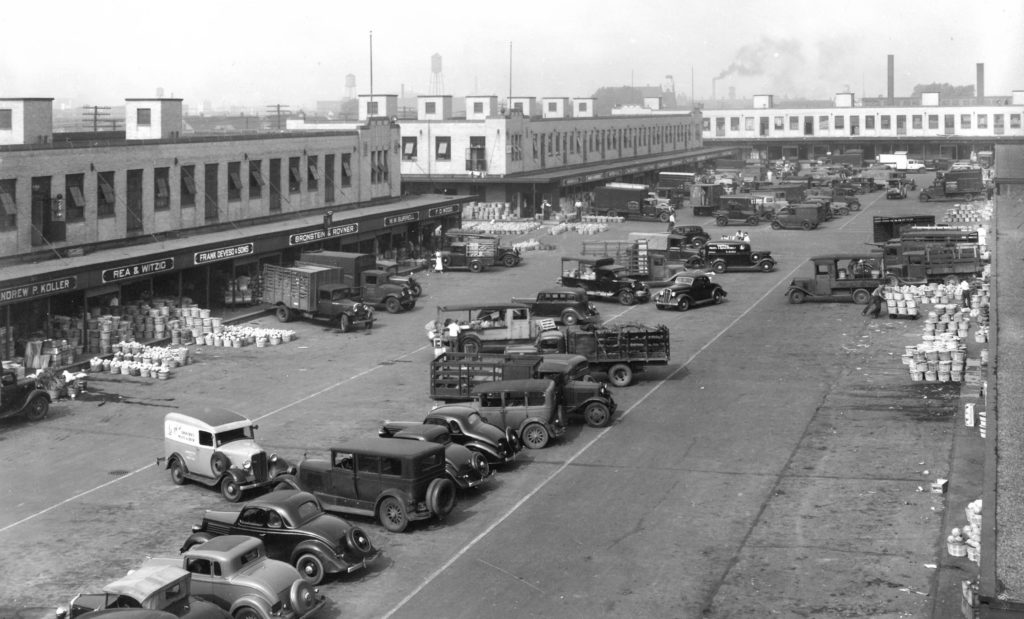History
Food Merchants Escape Early Buffalo Congestion
Prior to 1931, before the Niagara Frontier Food Terminal was established, the Elk Street Market and the wholesale district along Michigan Street were the centers for food distribution and marketing in the prosperous Buffalo, NY. The market on Elk street was a congested place with little space to move after farmers and merchants had laid out their products. Henry G. Marqet, President of the neighboring Niagara Frontier Growers Co-operative Market, remarked years later; “It sometimes took a man with horse and wagon an hour to get off the market once he had completed his business there.” (Buffalo Courier Express, 6/18/1950)
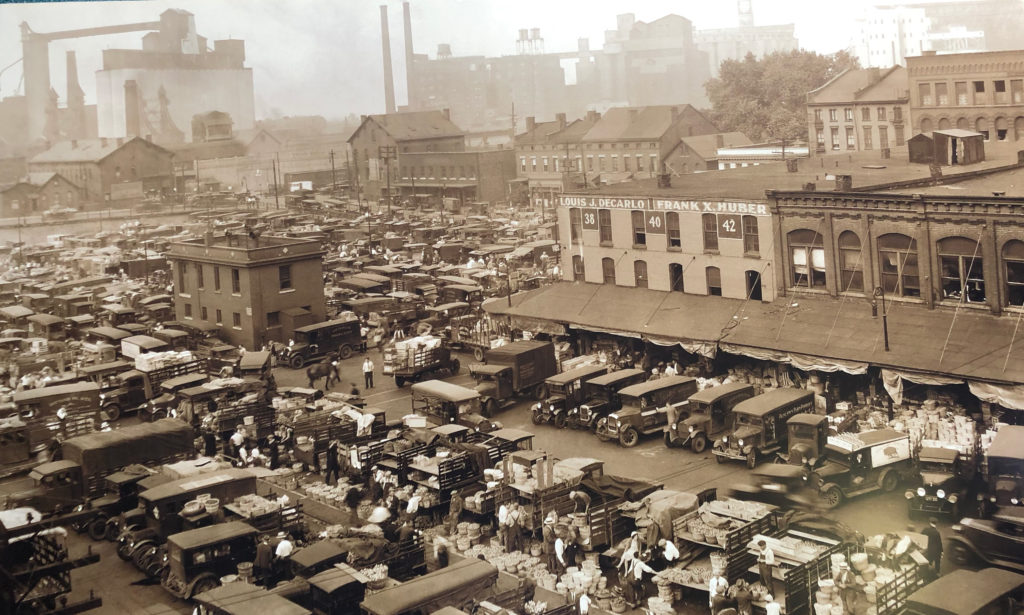
Above: Scene from the crowded Elk Street Market circa 1927.
Right: View of the Food Terminal from the Niagara Frontier Growers Co-Operative Market. Image courtesy of the Buffalo Historical Society
Prominent food proprietors who owned space in the Elk Street Market and Michigan Street district decided it was time for Buffalo to have its own state-of-the-art food market. These food merchants of early 1900’s Buffalo were the first tenants of the new Niagara Frontier Food Terminal, which they co-developed with the the Erie and the New York, Chicago & St. Louis Railroads – also known as the Erie and Nickel Plate Railroads. In 1931, the Food Terminal had 62 tenants, four wholesale grocers, one wholesale meats, one chain store and two national distributors.
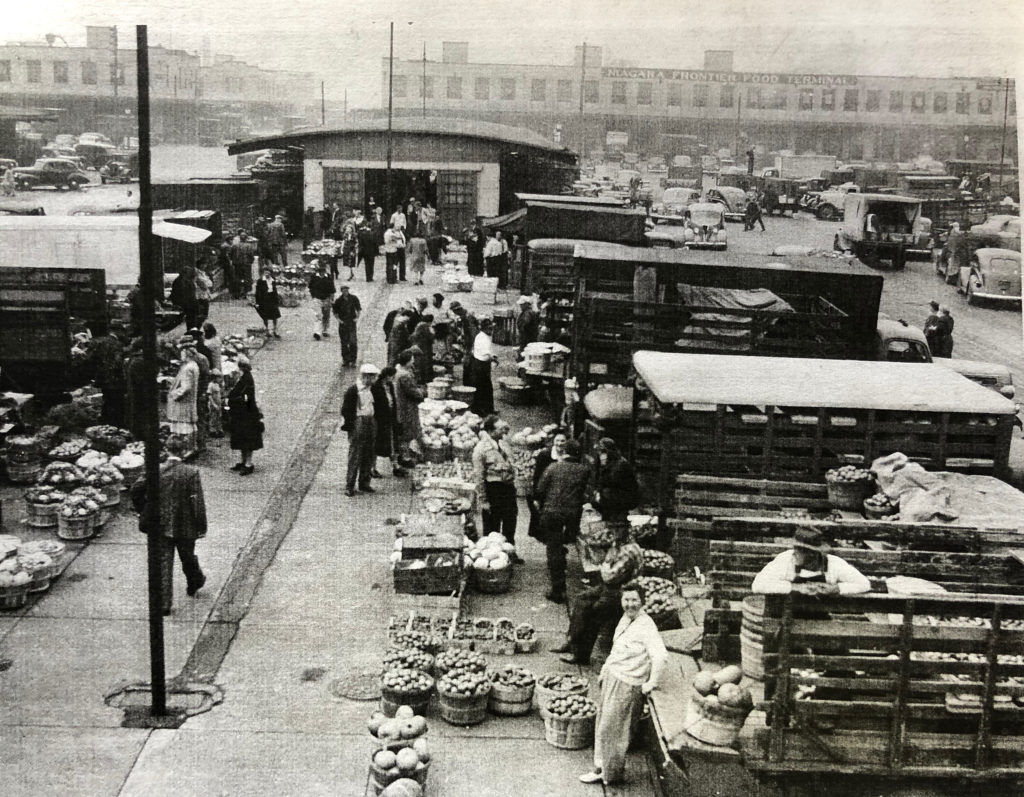
Original Tenants of the Niagara Frontier Food Terminal, 1931
A&G Produce; Harry Altman; American Produce; Banana Exchange; B.H Bean; Bierma & Kendrick; F. Brennisen & Son, Bredenberg Bros.; W.S. Buchart; Buffalo Butter& Egg Company; Buffalo Fruit & Vegetable Company; Buffalo Market Distributing Company; Sherman Bunshaft; William W. Burrell; M&T Cherico; Joseph Cherico; R.S Clum Inc.; Frank Deveso; B. Eberhardt & Son; John Eckert; Tom Elester; Esposito Bros.; Federal Fruit & Produce Company; John Hauser; Albert Hendel; Hickman, Coward & Wattles; Horn & Zimmer; I.V Horn Company; Joseph Infantine; Fred W. Kiefer; Andrew P. Koller;
George W. Kurtz; Leon Bros. Inc.; George B. Long; M.U. Mackey; H.A McAleer; Sam Morabito; National Fruit & Produce Company; Harry Nusinov; J.T Penfold; Joseph Polak; Satuloff Bros. Inc.; Nathan H. Satuloff Inc.; Scandurra & Galletta; Franklin F. Schafer; Irwin W. Schilling; John E. Schintizus, Robert A. Slacer; Slepian & Bachner; N.L Smith Co. Inc.; Snyder & Company; Sugarman Produce Company; Walter A. Tuttle Co. Inc.; Fred Unger; Vishion & Company; Frank E. Wattles; Wax & Sugarman Inc.; George R. Whitney Inc.; Wm C. Will & Company; Will & Zaepfel; F.D Wood; Zaubitzer & Miller.
Wholesale Grocers:
S.M. Flickinger Co. Inc; Granger and Co.; J.G Pieri Co.; Caesar A. Tronolone
Wholesale Meats:
Bell Packing Co. Inc
Chain Stores:
Loblaw Groceterias Inc.
National Distributors:
DiGeorgio Fruit Corp; Kraft-Phenix Cheese Company
Building Buffalo’s Food Hub
At a cost of $5,000,000 dollars ($83,000,000 in 2018 dollars) the railroads built one of the the largest and complete developments of its kind in the United States at the time of completion. Equity from the local food merchants’ properties in the Elk Street Market and Michigan Street Wholesale District was put into a holding company and used to take ownership of the Terminal from the railroad after completion. This created one of the only privately owned food market terminals in the United States. The company presently operates in the same manner; with family members of the original backers as stockholders and board members.
"One of the largest and and complete developments of its kind in the United States"
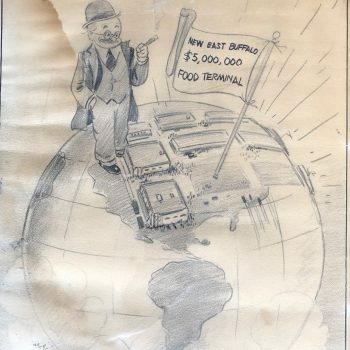
This represented a major commitment by the Erie and Nickel Plate and resulted in the second largest food terminal in New York State. The original 60-acre site had 10 fireproof buildings and included the Niagara Frontier Growers Co-operative Market to the south of Clinton Street, today known as the Clinton Bailey Farmers Market.
Each of the 10 buildings was built to be a complete market in itself. Various branches of the food industry were grouped for the convenience of the seller and buyer with facilities for display, ventilation, or refrigeration that each particular food required. Buildings were divided into 24 x 100 foot stalls for each merchant. Units face the wide plaza with sheltered truck-level loading platforms. There is also basement space for storage and a second floor for offices or sales rooms. The Food Terminal layout insured maximum lighting and air with freedom from congestion. Rail lines were built deep into the site, which allowed train cars to be unloaded into buildings in the west and east sides of the site.
The site at Clinton and Bailey was chosen for its wide streets and distance from city smoke, dust, and pollution to keep a sanitary environment for the processing of fresh food and produce. Proximity to rail lines was also a factor in site selection. The Erie and Nickel Plate built a rail yard with receiving tracks for 198 rail cars; team delivery tracks for 236 cars; and hold, inspection and icing tracks for 133 cars. Construction of the railroad tracks were completed by supervisors at the Erie Railroad. Architectural and engineering services in connection with the Terminal buildings was handled by the George S. Rider Company from Cleveland Ohio. The John W. Cowper Company of Buffalo was general contractor.
The Farmers Market eventually became its own entity in 1951 and three more buildings were constructed on the Terminals northern plots. (Seen as blank spots for future development in the graphic below). The two western buildings included one for butter and eggs and the other for poultry. These were eventually connected to form the largest building on the Terminal.
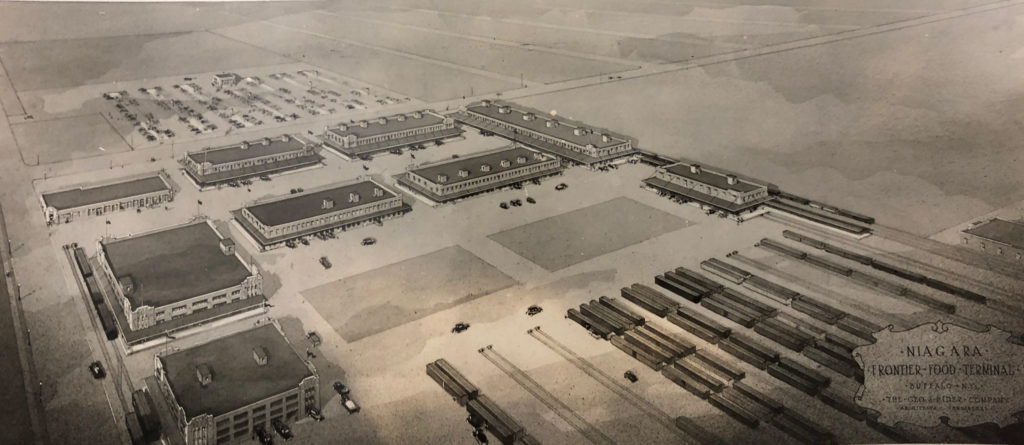
"A sixty-acre development of modern and scientifically designed buildings and facilities for the economical, efficient and clean marketing of food products."
Opening Day to Modern Day
The Niagara Frontier Food Terminal was officially opened on Monday March, 16, 1931. Local newspapers described much fanfare with Buffalo Mayor Charles Roesch speaking to a crowd of 10,000 people. It was estimated more than 50,000 people visited the new market buildings throughout the day. The celebration culminated with a dinner at the Hotel Statler, where civic leaders, railroad officials, and representative commission merchants from various parts of the U.S. were unanimous in characterizing the new produce market as not only an invaluable asset to Buffalos status as a food distribution center, but as a milestone in the growth of the produce industry in the United States.
The Food Terminal has diversified its tenants since the advent of truck shipping as the primary means of distributing food, freezer technology advancements, and grocery stores developing their own produce warehouses. Fresh produce companies became less common on the market. This led to the shift towards food distributors like Willowbrook Farms and U.S. Foods that store their goods in large freezers.
